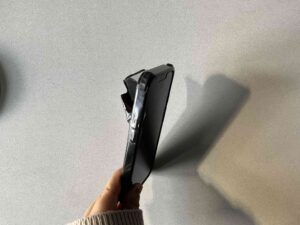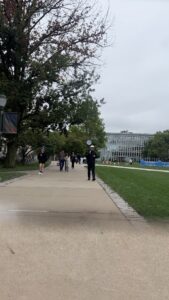TLDR: I take an embodied approach by intentionally physically colliding with students on campus who are enraptured by their devices to capture their reactions in real-time once they’ve escaped the digital landscape as a way or revealing how deeply technology influences our awareness, everyday interactions, and infiltrates our lives through subtle surveillance.
Research Question
How does cellphone use impact college students’ awareness of their surroundings and interactions with others while walking to class, especially their perception to subtle digital surveillance?
Inspirations
My project was initially inspired by several works brought up at the project’s introduction as initial inspiration as to what is a typography. I was drawn to these typographies primarily because they focused on capturing individuals’ emotional reactions in real-time, within consistent photographic environments, the only thing that changes is the individual depicted. The capture of spontaneous emotions like shock or surprise was something I was dying to emulate in my own work.
Bill Sullivan’s More Turns, a study of individuals passing through subway turnstiles.
B’s Typology on Surprise, capturing people’s surprise reactions as they opened a box.
Rachel Strickland, Portable Portraits, Cinema-verte interviews with individuals about the contents of their bags.
Later that week, after Nica and Golan introduced the project, I found campus students on their phones repeatedly running into me, AND an overwhelming majority never said sorry for the collisions. I kept noticing a ridiculous number of people completely absorbed in their devices, visibly bumping into random individuals as they walked. This made me want to illustrate just how embedded phones have become in our lives—especially for young college students—who can’t even put their phones down while walking. Our generation has literally grown up alongside technology’s rapid evolution into incredibly smart, handheld devices, and I wanted to explore this phenomenon of our attachment to technology and its silence surveillance over us.
Initially, I wanted to “go big or go home” and capture the paths of individuals on their phones using a drone to create a timelapse of their movements. However, critiques grounded me and encouraged a more interactive approach to capturing the collisions. One critique group reminded me of the effectiveness of using my own body as the medium that collides with these individuals, allowing my body to literally become part of the experiment—a point that Nica heavily encouraged
After the critiques, my idea shifted drastically: I would use my body to become the obstacle.
I wanted to gather some data to analyze the project in some way, Tega and the critiques also introduced the element of the qualitative interview, allowing me to ask the single question, “Could I ask what you were doing on your phone just now?” before walking away to see what happens. This added an element of qualitative research was something I was truly SO eager to incorporate, aiming to understand what was truly capturing individuals’ attention and analyze if there was any overlap.
Then came the question of how to capture this. I grappled with using a camera with a 360-degree lens or strapping one on, wondering how I could subtly film the entire footage without asking for permission. Ethics was heavily discussed, and since the footage is in a public place, turns out it’s all good–no permission required . After discussing my concerns with Golan, he suggested the PERFECT solution: a Creep Cam.
What is a Creep Cam, you may ask? It’s a small 45-degree prism used by predators on the subway to subtly look up people’s skirts. So, why not repurpose this unfortunately very clever idea in a completely new way?


Now that I had my concept and method of capture, it was time to bring it to life.
How Did I Develop My Machine?




I was going to 3D print mirrored acrylic, but encountered challenges with permission and printing on a weekend. Instead, I used a small mirror from my NARS blush compact, cardboard, black electrical tape, tape to cover 2/3 of my iPhone camera, and my personal phone to achieve the machine. I combined the cardboard with the compact mirror at a 45-degree angle and used black electrical tape to make the machine blend in with my phone. I also made sure that on the day I went to capture, I was wearing a black top, so it was even more difficult to tell that I was subtly filming people. Additionally, I wanted to look as put together as possible, aiming to draw people’s attention upwards rather than downwards. A little manipulative, but a success all the same!


How Did I Develop My Workflow?
Experimentation & a Small Set of Rules
I limited myself to the area between the CUT and the Mall, specifically near Doherty Hall to the UC. I needed to make sure I wasn’t actively making or forcing a collision; as long as I set myself on the same path, starting to walk and looking down at my phone—and capturing the video of anyone bumping into me or avoiding my path—that was fair game. I wasn’t sure if I needed to stay in place, be more active during rush hours, or walk around the cut, but I needed to experiment and see.
I wrote an empty backpack to fit the part, then started to walk around to see what happened and what individuals said.
Part of the process that was way more complex than I thought
1. More Time = More Awareness
It turns out that individuals are a bit more aware than I expected because I gave them more time to notice. What does this mean? Walking around the CMU grounds takes some time, and moving from one end of Doherty to the UC gives individuals more time to spot me than I would have liked. Interestingly, even though I provided them with this extra time, most people didn’t care or would purposely walk toward me to assert their presence and make a point of getting off their phones.

2. Green Tape on CMU Sidewalks Controls Traffic Flow
During rush hour, people behaved much like cars on either side of the road; the green tape on the CMU sidewalks made it easier for traffic to flow, creating an unspoken rule of staying in your lane that wasn’t there before. I had much more success colliding with people when I wasn’t fighting with the green tape separating the lanes. I often caught people on the diagonal paths from CFA to CS or from CFA to Doherty, or just in the Doherty area where more people were coming in or out right at rush hour.

3. Big Hallways don’t work!
I also attempted to capture interactions in hallways, but the larger hallways like Doherty and Baker contributed to the “stay in your lane” mentality.
4. Where did most of the bumps occur?
I realized that most of the bumps occurred when I was bombarded during rush hour by a variety of people, or during ridiculously slow times of the day when almost everyone was in class, a time when individuals knew it was okay to let their guard down.
Did I Succeed or Fail?
Overall, I would consider the project successful.

I had several people run into me, many react and walk around to avoid my path, and numerous individuals told me what they were looking at on their phones without questioning what I was doing (except for one person out of 30). This could be attributed to my nonchalant approach when asking the question, but I believe most people were still in a state of shock or confusion, which made it difficult for them to process my question. Even more, most people would turn their phone to show me, a true stranger, what they were looking at on their phone!!!!! I may just have a truly trusting demeanor haha! A majority of the individuals who answered my question said “grade scope” (CMU’s grading portal for exams/quizzes), “Checking my grades,” “finding my computer,” “scrolling instagram,” “texting my friend”. I would love to continue the project to gather more quantitative and qualitative insights: does time affect the answers gathered? Are there more phones out during exam week? More phones in the morning than later in the day? How many individuals will say they were on the same application?
The most fascinating aspect was that almost NO ONE recognized the invisible camera. No one asked me what I was up to or if I was recording them. No one told me I couldn’t do it, simply because they didn’t notice the camera! When I reflect on how I conducted the experiment, I’m completely sure that my behavior was a bit odd; just walking up to you asking a question, saying thank you, and then walking away. I was genuinely surprised that no one questioned me. The subtlety of not noticing the camera was a bit scary as it relate to the subtle surveillance perspective. However, when I shared my project with friends, they said, “That’s my worst nightmare, never do that to me!” The subtlety of the camera and the angle of looking down at my phone without noticing created a strong impact for the piece emphasizing the subtlety of surveillance and the impact of technology on our daily lives.
Where do I go from here?
I really want to continue this project!!! More quantitaitive/qualitative aspects to play with / analyze, more reactions of Shock/confusion to capture. I think this project, after having all this time to test and experiment, would benefit from just overloading on typographic captures. Similar to the initial inspirations I stated in the beginning. The only hinderance is being known as the person waiting to bump into people on the way to class…

CLICK HERE to view ALL of the videos (successful & unsuccessful) & photos on the Google Drive!
*Elements of this blog post have been updated regarding feedback received during critique*
